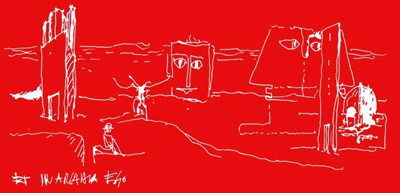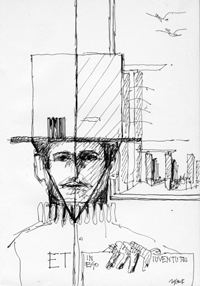You are in: Home page > Magazine Archive > Gianugo Polesello. Master of the indecipherable

Gundula Rakowitz
Gianugo Polesello. Master of the indecipherable
Venetian self-portraits

Gianugo Polesello, Et in Arcadia ego
The exhibition rooms in the ex-cotton works belonging to the IUAV University of Venice were home to the exhibition: Gianugo Polesello. Master of the Indecipherable Venetian self-portraits, curated by Gundula Rakowitz, and opened with an introductory lesson by Antonio Monestiroli, presented by the Project Archive, which keeps the Gianugo Polesello Archives, and by the Research Doctorate in Architectural Composition of the PhD School.
This travelling exhibition launched a display project by the architects Michele Barbiero, Franca Caberletti and Aldo Lamparelli, three former students of Polesello.
The exhibition illustrated the rigorous ‘Cartesian’ poetry of Gianugo Polesello’s architecture through a single but significant part of his overall thought process and compositional method, namely, the “Venetian Portraits”, occupying a central position in that montage of projects known as the “Venice Workshop”, a fundamental element of his architectural language.
The aim of the initiative was to make known, within the atemporal topicality of an a idea of architecture Polesello remained obsessively faithful to, the theoretical foundations behind the works of architecture he devised during his teaching and research within the School of Venice.
From the 1964 Novissime Project by the Samonà Group, passing via the project for the area of San Giobbe and Cavallino, to the projects for the Rialto Market and Accademia Bridge for the 1985 Biennial, The Italian Pavilion in the Biennial Gardens of 1988, the project for western Venice and the enigmatic 16 Towers for the first industrial area in Marghera, the Project for the San Michele Island Cemetery from 1998 and the project experiments for the Ideal City, first in the Isola di Rialto, then, between 1995 and 2001, in the Centuration of Camposampiero in the Venetian hinterland, to the project and creation of the East Padua motorway toll booth area in the Venetian metropolitan area, and his last project for a piece of imaginary architecture, La Libellula, dating to between 2001 and 2005.
The exhibition also offered the first opportunity to enter a territory hitherto little known regarding the architect’s personality, whose rigorous scientific nature and unceasing attention to the outlines of the discipline made him reluctant to succumb to any subjectivism: this territory is a look over an architectural Self marked off by a multiplicity of architectural self-portraits, a self-reflective reading which we get to know by simultaneously accompanying the multi-scale compositional understanding.
The event allowed its audience the possibility of a twofold reading or a 'twofold look': every niche that displayed a portrait of Venice was flanked, distinct from but at the same time consistent with the first, a ‘second’ level of reading, deliberately detached from the wall and as if suspended in space, in a series of extraordinary self portraits in which the moment of self-reflection was superimposed upon the project dimension.
Last but not least, the exhibition showed for the first time Gianugo Polesello’s highly personal sketch books hitherto unknown.
His teaching is to be rethought in Einfühlung with everything he didn’t say, didn’t draw, didn’t write. Polesello aimed to communicate the difficult cohabitation of rule and invention: within his Cartesian lesson, the system of rules, chance or accident just is; possible in the order of power. Consequently, every moment of the project is both a procedure to approach the final result, but is also a stage with its own autonomous logic, within the range of possible solutions. Power is the moment of the obscure, the uncertain, the enigmatic, inasmuch autographic, a turn of architectural thinking in the manner of the subject, evident in his last project, La Libellula: altitude-incertitude. Once displayed in its necessary possibility, the system of rules comes to constitute the foundation upon which to autograph, simultaneously maintaining certain parts of the Self, indecipherable, inexplicable and indescribable: but to be set in motion as simple seals of architectural truth which, absolute, exist in history, in the gesture of the subject.
As part of the Doctorate seminars, the curator organised on the morning of the 11 January 2012, a guided visit, while in the afternoon of the same day there was a square table, a dialogue between several speakers who, from reflection on Polesello’s poetry, wished to re-open the question of modern and very modern architectural thinking.
This square table, characterised by dynamic non-formal scientific research, was split, under the coordination of its creator and with an introduction by Serena Maffioletti, scientific head of the Project Archive, into a series of brief but significant interventions arranged by the latest generation of students who were necessarily asked to speak in order to contribute to that plurality of voices and gazes with which the Poleselli problem of the idea of architecture continues to be considered to this day.
Gundula Rakowitz is a PhD in Architectural Composition at the IUAV in Venice and tutor at the same Doctorate school.

Gianugo Polesello, Et in ego iuventute













